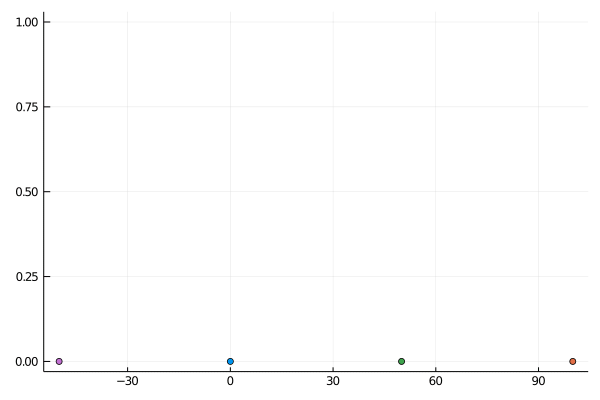Celestial objects are mainly governed by the gravitational force.
For two objects with masses \(m_1, m_2\) and distance \(r\) the force is given by
\[F_G = G \frac{m_1 m_2}{r^2}.\]
By Newtons second law the acceleration is proportional to applied force divided by mass
\[a = \frac{F}{m}.\]
For system with \(n\) bodies with positions \(x_1, \dots, x_n\) the dynamics can be described (simplified) by
\[m_j \ddot{x}_j = \sum_{i=1}^n \frac{m_i m_j}{\norm{x_i - x_j}_2^2} \frac{x_i - x_j}{\norm{x_i - x_j}_2},\]
where \( \frac{x_i - x_j}{\norm{x_i - x_j}_2} \) is a unit vector specifying the direction of acceleration.
This equations simplify to
\[\ddot{x}_j = \sum_{i=1}^n m_i\frac{x_i - x_j}{\norm{x_i - x_j}_2^{3/2}} = f_j(x_1, \dots, x_n).\]
It is convenient to write these equations in vector form \[\ddot{\bfx} = f(\bfx).\] Note that \(\bfx \in \mathbb{R}^{dn}\) with \(d \in \{1,2,3\}\) depending how many dimension we want to model.
The system dynamics can easily be brought in integral form \begin{align*} \dot{\bfx}(t) &= \dot{\bfx}(0) + \int_0^t f(\bfx(t)) dt \\ \bfx(t) &= \bfx(0) + \int_0^t \dot{\bfx}(t) dt. \end{align*}
For small \(\Delta t\) the integrals can be approximated by \begin{align*} \dot{\bfx}(t + \Delta t) &\approx \dot{\bfx}(t) + \Delta t \cdot f(\bfx(t)) \\ \bfx(t + \Delta t) &\approx \bfx(t) + \Delta t \cdot \dot{\bfx}(t). \end{align*}
Now one could use following discrete update scheme \begin{align*} \dot{\bfx}_{n+1} &\gets \dot{\bfx}_{n} + \Delta t \cdot f(\dot{\bfx}_{n}) \\ \bfx_{n+1} &\gets \bfx_n + \Delta t \cdot \dot{\bfx}_n. \end{align*} However, it turns out using the new velocity for the calculation of the position instead of the old one, \begin{align*} \dot{\bfx}_{n+1} &\gets \dot{\bfx}_{n} + \Delta t \cdot f(\dot{\bfx}_{n}) \\ \bfx_{n+1} &\gets \bfx_n + \Delta t \cdot \dot{\bfx}_{n+1}. \end{align*} yields better approximations. This scheme is called semi-implicit Euler scheme.
Below are two simulations. On the left side the bodies start on the quarter points of a sphere with tangential velocities. All have the same mass. On the right there is one very heavy body (the sun) in the center, two lighter objects (green and orange) and a 50 times heavier object (purple).

